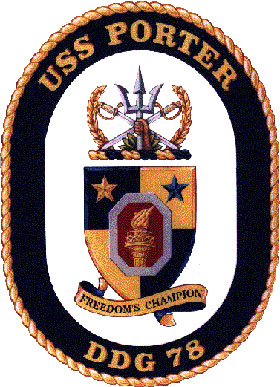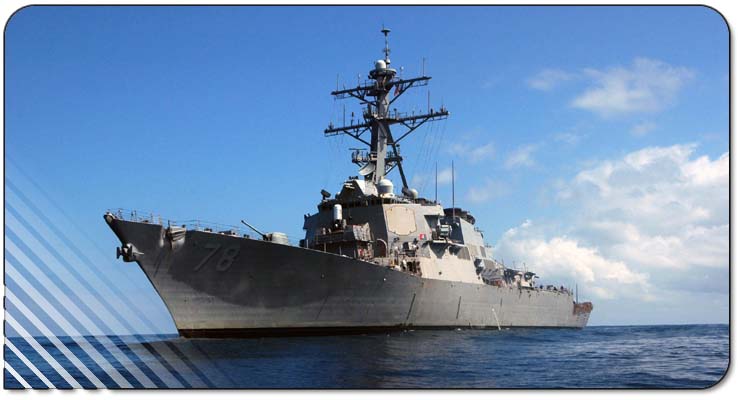Namesake:
Commodore David Porter / Admiral David
Dixon Porter
David Dixon
Porter was born on June 8, 1814, and was a native of Pennsylvania. He
was the second son of David Porter, who commanded the Essex in the
war of 1812-14 with Great Britain. Young Porter entered the service as
midshipman in February, 1829, and served in the Mediterranean until
1835, when he was employed for several years in coast survey and river
explorations. At the close of 1845 he was placed on special duty at the
Washington observatory, resigning in 1846 to take part in the Mexican
war. At the outbreak of the Civil War he was promoted to the rank of
commander, and in 1862 the mortar fleet for the bombardment of the
forts below New Orleans was placed under his orders. Vice Admiral David
Dixon Porter spent much of 1862-1863 along the Mississippi River and in
smaller Mississippi Rivers, including the Yazoo, the Coldwater, the
Tallahatchie, and the Yalobusha. He directed campaigns against a long
list of Confederate positions in the Mississippi Delta, from the Grand
Gulf batteries, to the Chickasaw Bluffs to Miliken's Bend and Port
Hudson. After the capture of New Orleans he went up the river with his
fleet, and was engaged in the unsuccessful seige of Vicksburg in July,
1862. During the second siege of that place, in the summer of 1863, he
bombarded the works and materially assisted Gen. Grant, who commanded
the besieging army. For this he made rear admiral. Porter did not leave
Mississippi until his successful support of General Grant's siege of
Vicksburg was completed with General Pemberton's surrender in July
1863. For his Civil War service, Porter received four letters of thanks
from Congress, and was promoted to Vice Admiral in 1866.
He was also engaged in the two combined attacks on Forth Fisher, which
commands the approaches to Wilmington, North Carolina. The first of
these attempts, at the close of 1864, miscarried; the second, in
January, 1865, was completely successful. In July, 1866, he was made
vice-admiral, and after the death of Farragut, was promoted, October,
1870, to the rank of admiral, which carried with it the command of the
entire navy of the United States, subject only to the order of the
president. Admiral Porter urged the importance of protecting the coast
approaches to all the large cities of the United States, with heavily
armored monitors, carrying the heaviest guns.
David Dixon Porter was nearly forgotten because his career and
accomplishments have often been misinterpreted, when, in fact, he was
arguably the foremost naval hero of the Civil War. Though Porter rose
faster through the ranks, commanded more men and ships, won more
victories, and was awarded more Congressional votes of thanks than any
other officer in the U.S. Navy, historians have been influenced by his
own postwar accounts, which were flawed by an unquenchable ego, thin
skin, and a burning desire to vindicate his equally controversial
father. David Dixon Porter was a firebrand hero of New Orleans,
Vicksburg, and Fort Fisher. His unique tactics and techniques rank
among the most imaginative and successful in naval history. The crew
onboard Porter's flagship encountered daring, brilliant attacks against
the punishing batteries at Vicksburg and Fisher and costly failures at
Steele's Bayou and Red River. David Dixon Porter held critical strategy
meetings with Sherman and Grant, and a thrilling chase up and down the
coast of South America after Semmes on the CSS Sumter. David Dixon
Porter was a talented fighter and colorful personality with a marvelous
sense of humor, earning respect and friendship from the likes of
Lincoln, Grant, and Sherman, but drew the ire of political generals
like Butler, Banks, and McClernand. He was a potent mix of energy,
ambition, courage, and creativity with rash behavior, paranoia, and a
taste for intrigue.
|
Ship's Crest:
 The Shield: Dark blue and gold represent
the sea and excellence and are the colors traditionally used by the
Navy; red is emblematic of sacrifice and courage. The shield is divided
in four recalling the previous USS PORTERS and highlighting the four
cardinal compass points and the US Navys world-wide mission. The stars
commemorate the battle stars earned in World War II by the second and
third USS PORTER. The Aegis shield symbolizes DDG 78s modern warfare
capabilities; and is red to reflect courage and action. The torch, from
the Statue of Liberty, suggests the ships motto and symbolizes the
principles of freedom upon which our country was founded. The Shield: Dark blue and gold represent
the sea and excellence and are the colors traditionally used by the
Navy; red is emblematic of sacrifice and courage. The shield is divided
in four recalling the previous USS PORTERS and highlighting the four
cardinal compass points and the US Navys world-wide mission. The stars
commemorate the battle stars earned in World War II by the second and
third USS PORTER. The Aegis shield symbolizes DDG 78s modern warfare
capabilities; and is red to reflect courage and action. The torch, from
the Statue of Liberty, suggests the ships motto and symbolizes the
principles of freedom upon which our country was founded.
The Crest: The crossed Naval Officers swords honor both
David PORTER and his son as well as representing the ships mission to
"Train, Fight and Win." The laurel, arm, and trident are adapted from
the US Naval Academy coat of arms; they highlight David Dixon PORTERs
tenure as superintendent of the Academy. The trident, the symbol of sea
power, alludes to the Aegis vertical launch system; its three tines
reflect the War of 1812, the Mexican War, and the Civil War that the
PORTERs served.
Motto: A scroll Or doubled and inscribed "FREEDOMS
CHAMPION" Azure.
|



 The Shield: Dark blue and gold represent
the sea and excellence and are the colors traditionally used by the
Navy; red is emblematic of sacrifice and courage. The shield is divided
in four recalling the previous USS PORTERS and highlighting the four
cardinal compass points and the US Navys world-wide mission. The stars
commemorate the battle stars earned in World War II by the second and
third USS PORTER. The Aegis shield symbolizes DDG 78s modern warfare
capabilities; and is red to reflect courage and action. The torch, from
the Statue of Liberty, suggests the ships motto and symbolizes the
principles of freedom upon which our country was founded.
The Shield: Dark blue and gold represent
the sea and excellence and are the colors traditionally used by the
Navy; red is emblematic of sacrifice and courage. The shield is divided
in four recalling the previous USS PORTERS and highlighting the four
cardinal compass points and the US Navys world-wide mission. The stars
commemorate the battle stars earned in World War II by the second and
third USS PORTER. The Aegis shield symbolizes DDG 78s modern warfare
capabilities; and is red to reflect courage and action. The torch, from
the Statue of Liberty, suggests the ships motto and symbolizes the
principles of freedom upon which our country was founded.


















